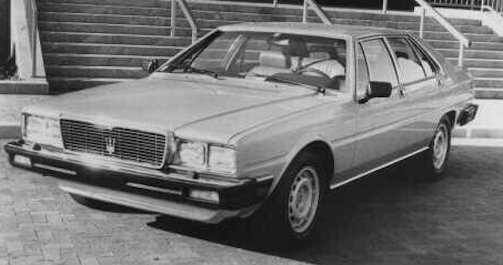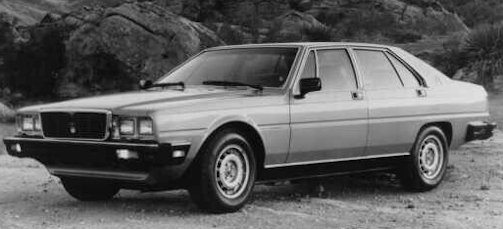Maserati Quattroporte III
 |
|
|
Production period: |
1979 to 1990 |
|
Class: |
Luxury Car |
|
Body versions: |
limousine |
|
Engines: |
Gasoline 4.2-4.9 litres |
|
Length: |
4910 mm |
|
Width: |
1890 mm |
|
Height: |
1385 mm |
|
Wheelbase: |
2800 mm |
|
Curb weight: |
1950 kg |
The Maserati Quattroporte III (initially as the Maserati 4Porte, factory designation: Tipo AM 330) was a sedan of the Italian sports car manufacturer Maserati, which was produced from summer 1979 to the end of 1990.
History
Together with the coupe Kyalami the first Maserati model, which was created after the acquisition of the company by Alejandro de Tomaso. With it, Maserati continued the tradition of sporty luxury limousines, which at the beginning of the 1960s with the Quattroporte I. The Quattroporte III also remained in the program during the era of the Maserati Biturbo. From summer 1986 this received the name Maserati Royale, and was the last Maserati model with classic Maserati eight-cylinder engine.
The first Quattroporte I introduced in the autumn of 1963 was produced until the end of 1970. At the beginning of its production, the car was a very successful model, but was considered outdated in recent years. De Tomaso needed at that time quickly a new Maserati model to demonstrate the ability of his company to act. The time-consuming redevelopment of a Maserati sedan was therefore excluded. As with the Kyalami presented in March 1976 de Tomaso therefore used in the development of a Quattroporte successor to existing substances of his own group: As a technical basis, the chassis of the sedan De Tomaso Deauville was based, which was only slightly changed. The model received the well-known Maserati eight-cylinder engines and an independent body, which - unlike the case of the Kyalami - no external resemblance to the De Tomaso base had.
The prototype of the Quattroporte III was presented at the Turin Motor Show in November 1976. It took nearly three more years for mass production to begin. From summer 1979 to mid-1986, 2,088 copies were created, 51 of them with the 4.2-liter eight-cylinder engine. From summer 1986 until the end of 1990 Maserati again produced 53 copies of the revised version Royale.
The body had been designed by Giorgio Giugiaro. The stylistic approach was based on Giugiaro's concept vehicle Maserati Medici.
The body of the Quattroporte III was designed self-supporting. It consisted of pressed sheet steel. The body shell was manufactured by Innocentia in Milan, a small car specialist, which belonged to the De Tomaso Group since 1975. The further production was partly done by hand. The structure of the Quattroporte III was, according to the Medici, characterized by straight lines. The passenger compartment was designed trapezoidal. The car had a high front end with two square twin headlamps, which had been taken over by the Fiat 125, and a distinctively modelled, chrome-plated grille. At the rear end there were high positioned, wide taillights. This design feature took over Volkswagen later for its Passat offshoot Santana.
The seats were standard with leather upholstery, which was initially available only in a shade of brown, from 1986 could also be ordered in white. The dashboard and some areas of the doors were clad in precious wood.
The undercarriage and the chassis of the Quattroporte III completely corresponded to that of De Tomaso Deauville. Only the wheelbase was slightly extended by 30 mm. Front and rear, the suspension of wishbones and coil springs. This lifted the car from the Quattroporte I, which was still equipped with a rear rigid axle and leaf springs. Four-disc brakes from Girling and a power - assisted ZF rack and pinion steering system were part of the chassis as standard. As of 1984, was limited slip differential Gleason built which had a variable locking effect. Maserati was the first car manufacturer to offer this design in a production car.

The Quattroporte III was driven exclusively by eight-cylinder engines, each with four overhead camshafts. The mixture was prepared by four Weber double carburettors, a gasoline injection was not available throughout the production period. The engines differed primarily by the cubic capacity and the compression:
- In the first three years of production, the 4.2-liter version of Maserati's eight-cylinder engine was the base engine. She made initially 255 hp, later 246 hp.
- PERFORMANCE: 4,136 cc
- max speed: 143 mph. 230 km/h
- max power (DIN): 270 hp (198.7 kW) at 6,000 rpm
- max torque (DIN): 289 1b ft. 40 kg m (392.3 Nm) at 3,800 rpm
- max engine rpm: 65 hp/l (48 kW/l)
- power. weight ratio: 14.5 lb/hp (19.7 lb/kW), 6.6 kg/hp (8.9 kg/kW)
- Fuel consumption: 22.1 m/imp gal, 18.4 m/US gal. 12.8 x 100 km.
- Throughout the production period was also the 4.9 litre version of this engine available; from 1982 it was the only available version. By the summer of 1986 she made 282 hp. Thereafter, the power increased as a result of an increase in compression to 300 hp. This version of the engine was used in the Maserati Royale.
- PERFORMANCE: 4,930 cc
max speed: 143 mph, 230 km/h
max power (DIN): 280 hp (206 kW) at 5,600 rpm
max torque (DIN): 289 1b ft, 40 kg m (392 Nm) at 3,000 rpm
max engine rpm: 6,000; 56.8 hp/l (41.8 kW/l)
power-weight ratio: 15 lb/hp (20.3 lb/kW), 6.8 kg/hp (9.2 kg/kW)
Fuel consumption: 14.9 m/imp gal, 12.4 m/US gal, 19 1 x 100 km.
As a power transmission was initially only a manual five-speed transmission from ZF available; From 1981, a Torque-Flite automatic three-speed transmission from Chrysler was available as an alternative. It was ordered by nearly 85% of all customers.
The Maserati Royale produced from the summer of 1986 differed externally and technically only slightly from its predecessor Quattroporte. Technically, this includes an increased to 9.5: 1 compression of the engine, which led to a power increase to 300 hp. The interior had a fridge for the rear passengers, in addition came picnic tables, which were housed in the door trim in the idle state and could be unfolded as needed. According to factory specifications, the seats of the Royale were padded even better than the Quattroporte III.
In 13 years of production Maserati produced almost 2,200 copies of the Quattroporte III. Most of the vehicles were sold in the USA, as expected by De Tomaso. The car was thus the most built and successful Maserati model before the Biturbo era. At the Carrozzeria Pavesi in Milan received in the early 1980s, some Quattroporte sedans a subsequent Armor; most of them went to Italian politicians like the President. In addition, Pavesi has also converted two.

Technical
-
Maserati Quattroporte III Technical details and specifications (1979-1990)
ENGINE: 4,136 cc
4 stroke; 8 cylinders, Vee-slanted at 900:
Engine capacity: 252.3 cu in, 4,136 cc
bore and stroke: 3.46 x 3.35 in. 88 x 85 mm
compression ratio: 8.5:1
light alloy block and head, wet liners, hemispherical combustion chambers
5 crankshaft bearings
valves: overhead; camshafts: 2, per cylinder block. overhead. chain driven
lubrication: gear pump, full flow filter
Weber 42 DCNF downdraught twin barrel carburettors
fuel feed: electric pump: water-cooled
electrically-controlled fansENGINE: 4,930 cc
location front
4 stroke; 8 cylinders, Vee-slanted at 90°
Engine capacity: 300.8 cu in, 4,930 cc
bore and stroke: 3.70 x 3.50 in, 93.9 x 89 mm
compression ratio: 8.5:1
light alloy block and head, wet liners, hemispherical combustion chambers
5 crankshaft bearings
valves: overhead; camshafts: 4, 2 per bank, overhead, chain-driven
lubrication: gear pump, full flow filter
17 imp pt, 21 US pt, 9 1
4 Weber 42 DCNF downdraught twin barrel carburettors
fuel feed: electric pump
water-cooled, 2 electric fans.TRANSMISSION
driving wheels: rear
gearbox: automatic transmission, hydraulic torque converter and planetary gears
with 3 ratios, max ratio of converter at stall 2.75 possible manual selection
ratios: 1st 2.400, 2nd 1.470, 3rd 1, rev 2.700
gear lever location: central
axle ratio: Auto 3.310 manual 3.540
(Optional) 5-speed fully synchronized ZF mechanical gearbox (1 2.990, Il 1.900, Ill 1,320, IV 1, V 0.890, rev 2.700),
(Optional) hypoid bevel final drive
(Optional) limited slip differential.CHASSIS
integral
front and rear suspension: independent, wishbones, coil springs, anti-roll bar,telescopic dampers.STEERING
rack-and-pinion, adjustable height and distance, servo
turns lock to lock: 2.50.
turning circle: 35 ft, 11.5 mBRAKES
disc, internal radial fins, dual circuit, servo
swept area: front 245.4 sq in, 1,583 sq cm
swept area: rear 188.5 sq in, 1,216 sq cm
swept area: total 433.9 sq in, 2,799 sq cm.ELECTRICAL EQUIPMENT
12 V
72 Ah battery
650 W alternator
Bosch electronic ignition
4 iodine headlamps.DIMENSIONS AND WEIGHT
wheel base: 110.20 in, 280 cm
front and rear track: 60,03 in, 152 cm
length: 196 in, 498 cm
width: 70.47 in, 179 cm
height: 53.14 in, 135 cm
ground clearance: 5.55 in, 14 cm
weight: 4,190 1b, 1,900 kgModel comparison data
Quattroporte 4200
Quattroporte 4900
Royale
Engine:
Eight-cylinder V-engine (four-stroke)
displacement:
4,136 cc
4928 cc
Bore × stroke:
Power at 1 / min:
188 kW (255 hp) / 6,000
207 kW (282 hp) / 5,600
221 kW (300 hp) / 5,600
Maximum torque at 1 / min
392 N · m / 3000
Compression:
8.5: 1
9.5: 1
maximum speed:
220 km / h
214 km / h
230 km / h
Consumption:
19.5 litres / 100 km
25.5 litres / 100 km
© Motor car History
Service
-
Maserati Quattroporte III Service Guide (1979-1990)
Width of rims: 7"
Tyres: 225/70 VRx 15 XDX tubeless. tyres: 215/70 VRx 15 XDX tubeless.
Carrying capacity: 1,103 1b, 500 kg
Fuel tank: 22 imp gal, 26.4 US gal, 100 14,136 cc
fuel: 98-100 oct petrol
oil: engine 17.6 imp pt, 21.1 US pt. 10 1, SAE 10W/50, change every 3.000 miles, 5,000 km
gearbox and final drive 2.5 imp pt. 3 US pt, 1.4 1, SAE 90, change every 12.400 miles, 20,000 km
coolant capacity: 28 imp pt. 33.5 US pt. 16 1, 2
greasing: every 3,100 miles, 5,000 km
sparking plug type: Bosch 200 T 30
tappet clearances: inlet 0.011 in, 0.25 mm, exhaust 0.024 in. 0.50 mm
valve timing: 40° 80° 55° 25°
tyre pressure: front 31 psi, 2.2 atm. rear 34 psi, 2.4 atm.4,930 cc
fuel: 98-100 oct petrol
oil: engine 17 imp pt, 21 US pt, 9 1, SAE 10W/50, change every 3,000 miles, 5,000 km
gearbox 2.5 imp pt, 3 US pt, 1.4 1
final drive 2.5 imp pt, 3 US pt, 1.4 1, SAE 90, change every 12,400 miles, 20,000 km
greasing: every 3,100 miles, 5,000 km
coolant capacity:28 imp pt, 33.5 US pt
sparking plug: Bosch 200 T 30
tappet clearances: inlet 0.011 in, 0.25 exhaust 0.024 in, 0.50 mm
valve timing: 40° 80° 55° 25°
tyre pressure: front 36 psi, 2.5 atm,• rear 37 psi, 2.6 atm.© Motor car History
